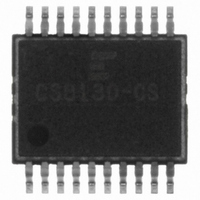CS8130-CS Cirrus Logic Inc, CS8130-CS Datasheet - Page 9

CS8130-CS
Manufacturer Part Number
CS8130-CS
Description
IC IR TRANSCEIVER 2-5V 20-SSOP
Manufacturer
Cirrus Logic Inc
Type
Transceiverr
Datasheet
1.CS8130-CS.pdf
(28 pages)
Specifications of CS8130-CS
Mounting Type
Surface Mount
Voltage - Supply
2.7 V ~ 5.5 V
Package / Case
20-SSOP
Logic Case Style
SSOP
No. Of Pins
20
Peak Reflow Compatible (260 C)
No
Supply Voltage Max
5.5V
Transceiver Type
Infrared
Driver Case Style
SSOP
Leaded Process Compatible
No
Lead Free Status / RoHS Status
Contains lead / RoHS non-compliant
For Use With
598-1161 - BOARD EVAL FOR CS8130
Number Of Drivers/receivers
-
Protocol
-
Lead Free Status / RoHS Status
Contains lead / RoHS non-compliant, Contains lead / RoHS non-compliant
Other names
598-1203-5
Available stocks
Company
Part Number
Manufacturer
Quantity
Price
Part Number:
CS8130-CSZ
Manufacturer:
CIRRUS
Quantity:
20 000
The modulation frequency is determined by the
modulator divider registers. The transmit bit rate
is determined by the TV Remote transmit bit rate
divider. The UART to CS8130 baud rate must be
set to at least 20% faster than the transmit bit
rate.
Receive Path
A PIN diode is attached to the PINA and PINC
pins. Compensation for the DC ambient light is
applied to the photocurrent from the diode. The
change in photocurrent from ambient is ampli-
fied and compared to a threshold value. If the
photocurrent is greater than the set threshold, the
output is set to ’light’. If the photocurrent is less
than the set threshold, the output is set to ’no
light’. The threshold current is programmable.
This allows users to make the tradeoff between
noise immunity and the reliable transmission dis-
tance of the link. The PIN diode amplifier has a
bandpass filter characteristic, to limit the effects
of IR interference. The resulting logic signal is
further qualified, depending on the IR format se-
lected.
An autodetect feature is provided. If autodetect
mode is enabled, and transmit TV remote mode
is disabled, the FORM/BSY output pin indicates
DS134PP2
DS134F1
TXD*
TXD*
FORM/BSY
LED
OUTPUT
* TXD Baud rate can be set
from 4800 to 115200 bps
Start
Bit
Figure 5. Mode 3 (TV Remote) Transmit Data Format
1
0
1/2400
A
1
1
1
0
0
0
1
0
1
A
1
0
Stop
Bit
B
the format of incoming data. If high, then the
incoming data is in IrDA/HPSIR format. If low,
the data is in ASK format which matches the
programmed modulation frequency.
Mode 1 (IrDA) Receive Choices
For Mode 1a, a logic circuit is set to only look
for pulse widths of 1.6 s. For Mode 1b, a logic
circuit looks for pulses of 3/16 of the set baud
rate bit period. For Mode 1c, a logic circuit
looks for pulse widths of 1.6 s, but 3/16 of
the set baud rate bit period.
Mode 2 (ASK) Receive Choices
For Mode 2, a logic circuit looks for sequences
of ’light’ and ’no light’ which matches the ex-
pected 500kHz carrier. The modulator divider
registers must be set to 6. The ASK receive tim-
ing sensitivity register should be set to 0,
yielding a valid incoming frequency range of
461 kHz to 614 kHz.
The RXD data transitions will lag behind the in-
frared activity by 3 modulation cycles. This
allows the modulation detect circuit time to ver-
ify the correct modulation frequency.
0
0
1
1
0
0
C
1
B
1
0
0
0
1
C
ON
OFF
CS8130
CS8130
9
9

















